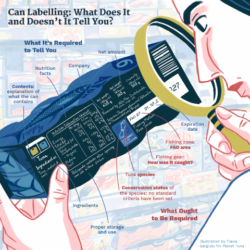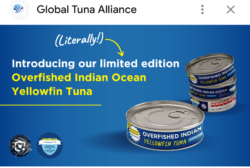Read Time: 5 Minutes Subscribe & Share
For the life of me, I cannot remember which marvelous food writer (perhaps Waverly Root or Roy Andries De Groot) wrote about going to lunch at a drugstore in Manhattan with one of his colleagues (they were both lowly proofreaders, in a publishing house, I believe). Anyway, the writer, being new to the job, ordered the same lunch as his new friend — which was a tunafish salad sandwich. Much to his dismay, it was at best almost tasteless. His workmate, however, was stolidly munching through his without complaint. The author remarked to him that the sandwich was terrible and he would not order it again. His colleague agreed that the sandwich was indeed awful. The next day, they went to the same drugstore, and his friend ordered the same sandwich. The author expressed shock that he would order a sandwich that, the day before, he had decried as tasting terrible. To which his workmate replied, “I really don’t care what I eat.”
What’s In A Can?
In the case of the plebian canned tuna that we toss into our grocery carts, we should care. We should at least read the labels, which provide us with some useful information both in the Americas and in Europe. There are also organizations and government entities that work to improve the conditions of this most consumed canned fish in the world. As consumers we need to choose sustainably sourced and not overfished stocks of this tinned staple. As you can decipher from the graphic, there is a lot of information to be gleaned from a label’s seeming hieroglyphics, which among other things explain the requirements for sustainable fishing methods.
improve the conditions of this most consumed canned fish in the world. As consumers we need to choose sustainably sourced and not overfished stocks of this tinned staple. As you can decipher from the graphic, there is a lot of information to be gleaned from a label’s seeming hieroglyphics, which among other things explain the requirements for sustainable fishing methods.
Approach with some skepticism. There are fewer than 20 species of tuna, and while the term “albacore tuna” is usually on the label of US canned tuna, apparently often it is not actually “albacore.” It can also be Skipjack tuna (bonito is another name) or Yellowfin. Most websites that are watchdogs over the fishing industry are begging us to look for Pacific Albacore, which must have “pole and line caught” or “trolled” on the label. Skipjack tuna is abundant, but it is usually fished unsustainably. In fact, the character that we grew up with, “Charlie” from Starkist, aimed to persuade us that the company stood for the highest quality, tastiest tuna. The fishing line and hook in so many ads hinted at responsible catch practices. Starkist Tuna is actually a wholly owned subsidiary of a Korean company, Dongwon Industries, and the canning process is mostly done in Saipan. They are also a leader in the purse seine fishing industry, an enemy of fish sustainability. In fact, this company is the lowest rated canned tuna for sustainability standards (even lower than Bumble Bee) on the Greenpeace Tuna Guide. Sorry, Charlie.
How To Catch A Tuna
I can recommend two very good information sources: first is the venerable Seafood Watch website run by the Monterey Bay Aquarium. The second is actually the Greenpeace (which makes headlines for its dramatic protests) website. Both warn against the overfishing of Bluefin tuna. While there are a few tuna farms, unlike the proliferation of salmon farms that I wrote about in some earlier posts, your canned tuna gets caught in the ocean using the following methods: the most egregious (and one that we all should avoid purchasing) is the purse seine method. In addition to huge nets, which pick up everything from the bottom of the seafloor and upwards, there is the additional nightmare of Fish Aggregating Devices or FADs. These can be natural and biodegradable, such as trees, or they can be manufactured and non biodegradable. Both attract all marine life into the netted area and increase the catch of targeted fish like skipjack tuna, but also massively increase the catch of juvenile fish and other non-targeted marine life. This disregard for the loss of non-targeted marine life and the juvenile tuna inevitably will kill off the industry itself.
The bottom line (no pun intended) is that you want your choice of canned tuna to have the words pole caught, pole and line caught, troll-caught, or at the very least – FAD free or free school on the label.
Pole Caught means a single line off of a fishing pole is used to catch a single fish. Pole and line caught are variants of the same term. This ancient method of fishing a single species, while more expensive, returns non-targeted marine life back to the water. Troll caught is the fishing method of enticing a school of fish to follow a moving boat by dragging bait or a series of lures. Again, non-targeted species are “off the hook” and returned to the sea or lake. FAD-free means that no fish-aggregating devices were used in the indiscriminate purse seine netting of marine life. FADs increase the number of marine life that get caught in a net measuring several kilometers. Free school means that the fish were caught in a purse seine net without the use of FADs.
In buying canned tuna in the US at your supermarket, the only two that have any real sustainable fish product policies in place are Whole Foods and MOMs, according to the Monterey Seafood Watch website. And apparently, tuna (mostly yellowfin) caught by fisheries operating in the Indian Ocean have an abysmal record that matches that of Starkist. Much of this tuna is sold in the European market – and there are organizations at work to bring these fisheries, many operating out of the Seychelle Islands- into the sustainable fishing fold.
 This takes persuasion based on scientific data, public shaming and, of course, consumer refusal to buy products that ignore sustainability standards. One such organization is the Global Tuna Alliance, founded in the Netherlands and it uses a variety of tools to upgrade the tuna industry, including its own can of overfished tuna as a public relations gimmick. Each can boasts a QR code that sends you to a fact-filled page about the unsustainability of Indian Ocean tuna harvesting. What is intriguing about this organization is that it is organized by retailers and producers in the tuna supply chain and not the typical advocacy warriors such as Greenpeace. And like Aldi, Whole Foods, and Moms, which are all members of sustainable fishing organizations, we consumers have a role to play by saying “sorry” to irresponsibly caught tuna.
This takes persuasion based on scientific data, public shaming and, of course, consumer refusal to buy products that ignore sustainability standards. One such organization is the Global Tuna Alliance, founded in the Netherlands and it uses a variety of tools to upgrade the tuna industry, including its own can of overfished tuna as a public relations gimmick. Each can boasts a QR code that sends you to a fact-filled page about the unsustainability of Indian Ocean tuna harvesting. What is intriguing about this organization is that it is organized by retailers and producers in the tuna supply chain and not the typical advocacy warriors such as Greenpeace. And like Aldi, Whole Foods, and Moms, which are all members of sustainable fishing organizations, we consumers have a role to play by saying “sorry” to irresponsibly caught tuna.

Kitchen Detail shares under the radar recipes, explores the art of cooking, the stories behind food, and the tools that bring it all together, while uncovering the social, political, and environmental truths that shape our culinary world.




Comments are closed here.
Follow this link to create a Kitchen Detail account so that you can leave comments!